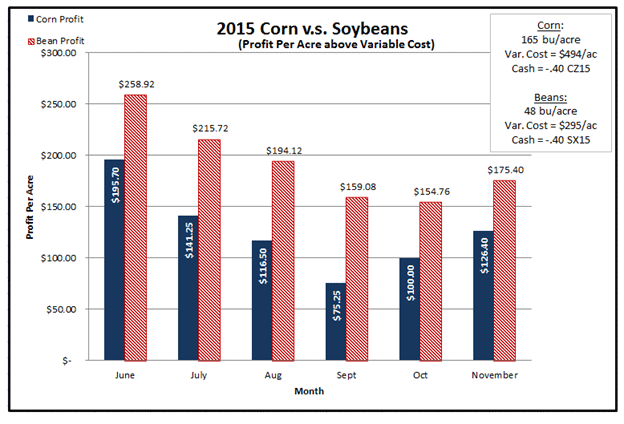Abundant crops
A U.S. REPORT
Disclaimer: Comments in this article are market commentary and are not to be construed as market advice. Derivatives trading involves substantial risk of loss, and you should fully understand those risks prior to trading.
AS WE END another year, it is nice to reflect back on the planting and growing season just completed. The United States Department of Agriculture’s (USDA’s) November crop estimates (the latest report available at press time) confirmed the U.S. grew a big corn and soybean crop in 2014.
The report showed a record corn yield of 173.4 bushels per acre and a record soybean yield of 47.5 bushels per acre. The corn yield was a new record by nine bushels per acre. Many areas of the country experienced record to near record yields. Nowhere was this more evident than in the middle of the corn-belt.
| 2014 Yield | Previous record | Difference | |
| Indiana | 186 | 171 | + 15 |
| Missouri | 181 | 162 | + 19 |
| Illinois | 200 | 179 | + 21 |
Thanks to improved farming practices, better seed, and a nice growing season, we have managed to grow the largest corn and soybean crops ever in the United States. Despite predictions of record demand, these large crops have left us with a very comfortable feeling carryout in both corn and soybeans.
Not only has the U.S. experienced a nice growing season, but, for the most part, the rest of the world has also been successful in producing a bountiful harvest. World corn carryout today is predicted to be 191.5 MMT and soybean carryout is believed to be a record 90.28 MMT.
The large crops and comfortable carryouts will be the main market factors influencing grain prices going forward. With this in mind a person’s marketing plans should be racketed lower to reflect the current situation.
The one factor that will not go away is the fact that the U.S. demand for corn is a record 13.66 billion bushels. At today’s price levels, this demand looks pretty solid; which I feel brings us to the next real job of the market — to make sure we plant enough corn next year!
Prior to the rapid expansion of the ethanol industry that started in 2007, the U.S. farmer liked to plant 78 to 80 million acres of corn. In 2012, the corn growers planted a modern day record 97.3 million acres. Since then, we’ve planted 95.4 million acres in 2013 and 90.9 million acres in 2014.
This year’s record corn yield has allowed 90.9 million planted acres to produce 14.4 billion bushels of corn, enough to meet our record demand plus increase the left over stocks to a burdensome level. The market would probably be a lot more comfortable moving through the 2015 growing season knowing we planted enough acres that we don’t have to set another record yield to supply the 13.66 billion bushel demand in 2015/2016 crop year.
You might ask, how hard does the market have to work? Not knowing many producers who would voluntarily idle acres without some type of government incentive, how hard it has to work is more about the ratio between corn and soybeans. The chart to the right is an attempt at a producers profit per acre over variable costs using fall of 2015 futures for corn and soybeans. Your operation may need to use different costs or yields, but for the sake of consistency we’ve used the highlighted information.

Early in the summer of 2014 these factors showed a $63 per acre advantage to the soybean market. By September that premium had grown to $84. Since the low water mark on this spread, the markets have been working to correct this and currently have the difference down to around $49.
Weather in South America, military conflicts around the world, or a sudden change in Chinese demand, and the markets can swiftly have other things to concern itself with. But if you make the assumption that normal will prevail, I feel this price ratio and the producers reaction to it will be the main market function through the winter and into the spring planting season. •
Cal Whewell is a risk management consultant and regional director with FCStone who specializes in grain markets. Whewell has worked for FCStone for 21 years and over the years has worked with many Canadian firms. Using the tools offered through the futures market, Whewell has helped these firms manage their price risks and increase their margins.









